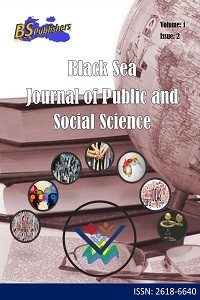Dehyariha A Successful Participatory Model for Sustainable Management and Development in Rural Regions of Iran
Abstract
Nowadays we see a new
and local model for rural management in Iran namely "Dehyariha" from
1998. For accessing to sustainable rural development, local management is a
very important and necessary issue. This local management must consider
villagers and training them in several related concepts such as local
development, appearing initiatives, collectivism and participation in rural
affairs and applying as an agent for analyzing and diagnosing economic, social
and environment aspects in these residence places. "Dehyaran (Officers in
Dehyariha)" as selected agents by villagers, also are agents of Iran
government in rural regions are responsible for various duties such as
fundamental and infrastructures, economic, social and environment aspects.
"Dehyariha" as Non-Governmental Organizations (NGOs) and popular
organizations with utilizing of helps and financial and etc. are getting various
assistances from the Municipality Organization and from Ministry of the
Interior. In this research author investigating and discussing various aspects
of sustainable economic, social and environmental development effects of
Dehyariha in the South Khorasan province in east of Iran. Also find correlation
relationships between independent variables (age, education, economic situation
of villagers) and dependent variables (Economic, environmental, collectivism,
social capital, sustainable rural development, and amount of adaptation
services presented by Dehyariha with real needs of villagers in this province).
Findings of this research indicated that despite approximately short time of
establishing and working of "Dehyariha", they could have major
positive changes in economic, social and environment aspects in the villages in order to accessing
sustainable development in these rural regions of Iran. In the end, author
developed approaches and alternatives for increasing positive economic, social
and environmental effects of Dehyariha in Iran.
References
- impact of Dehyary on waste management in the villages of rural perspectives (Case Study, Sarbok District, Qasreqand County). J Rural Res, 6(2): 275-298.
- Anchorena J, Anjos F. 2015. Social ties and economic development. J Macroecon, 45 63–84.
- Ardehali MM. 2006. Rural energy development in Iran: Non-renewable and renewable resources. Renew Ener, 31: 655–662.
- Azmi A, Imani B, Nosrati F. 2016. Study of Rural Management and Its Challenges in Iran Case study: Caraganrood District in Iran. Caspian Sea J, 10(1): 187-191.
- Ciochina I, Iordache C, Marin C. 2014. Analysis of Economic and Social Development of Valcea County Based on the Models with Simultaneous Equations. Proc Econ Finan, 16: 480– 488.
- Fallsolayman M, Sadeghi H, Ferozan MM. 2014. The Evaluation of Dehyariha Role in Prevention and Reduction of Health – Therapeutic Crisis in Rural Settlements. Case Study: Shosf District of Nehbandan County. Geog Plan Space Quart J, 4(12): 54-78.
- Farahani H, Khani Ahmad R. 2013. Evaluation the rule of Dhyariha in quality of life in rural areas; case study: Keresf, Khoda Bande. Urban Manage, 10(30): 195-206.
- Gobattoni F, Pelorosso R, Leone A, Ripa MN. 2015. Sustainable rural development: The role of traditional activities in Central Italy. Land Use Policy, 48, 412–427.
- Golmohammadi F. 2013. Sustainable rural development in Iran: challenges and opportunities (case study: south Khorasan province). Tech J Engin Appl Sci, 3(1): 170-185.
- Huhe N, Chen J, Tang M. 2015. Social trust and grassroots governance in rural China. Soc Sci Res, 53: 351–363.
- Iacob SE. 2015. The role of the forest resources in the socioeconomic development of the rural areas. Proc Econ Finan, 23: 1578–1583.
- Kyriacou AP. 2016. Individualism-Collectivism, Governance and Economic Development. European J Polit Econ, 42: 91-104.
Abstract
References
- impact of Dehyary on waste management in the villages of rural perspectives (Case Study, Sarbok District, Qasreqand County). J Rural Res, 6(2): 275-298.
- Anchorena J, Anjos F. 2015. Social ties and economic development. J Macroecon, 45 63–84.
- Ardehali MM. 2006. Rural energy development in Iran: Non-renewable and renewable resources. Renew Ener, 31: 655–662.
- Azmi A, Imani B, Nosrati F. 2016. Study of Rural Management and Its Challenges in Iran Case study: Caraganrood District in Iran. Caspian Sea J, 10(1): 187-191.
- Ciochina I, Iordache C, Marin C. 2014. Analysis of Economic and Social Development of Valcea County Based on the Models with Simultaneous Equations. Proc Econ Finan, 16: 480– 488.
- Fallsolayman M, Sadeghi H, Ferozan MM. 2014. The Evaluation of Dehyariha Role in Prevention and Reduction of Health – Therapeutic Crisis in Rural Settlements. Case Study: Shosf District of Nehbandan County. Geog Plan Space Quart J, 4(12): 54-78.
- Farahani H, Khani Ahmad R. 2013. Evaluation the rule of Dhyariha in quality of life in rural areas; case study: Keresf, Khoda Bande. Urban Manage, 10(30): 195-206.
- Gobattoni F, Pelorosso R, Leone A, Ripa MN. 2015. Sustainable rural development: The role of traditional activities in Central Italy. Land Use Policy, 48, 412–427.
- Golmohammadi F. 2013. Sustainable rural development in Iran: challenges and opportunities (case study: south Khorasan province). Tech J Engin Appl Sci, 3(1): 170-185.
- Huhe N, Chen J, Tang M. 2015. Social trust and grassroots governance in rural China. Soc Sci Res, 53: 351–363.
- Iacob SE. 2015. The role of the forest resources in the socioeconomic development of the rural areas. Proc Econ Finan, 23: 1578–1583.
- Kyriacou AP. 2016. Individualism-Collectivism, Governance and Economic Development. European J Polit Econ, 42: 91-104.
Details
| Primary Language | English |
|---|---|
| Journal Section | Research Articles |
| Authors | |
| Publication Date | July 1, 2018 |
| Submission Date | December 16, 2017 |
| Published in Issue | Year 2018 Volume: 1 Issue: 2 |


